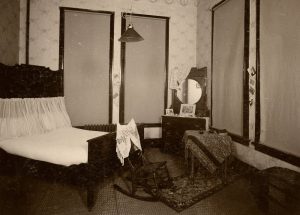
by Rachel DeShong, Special Event Coordinator and Map Curator
Today, we think nothing of flipping a switch and having instant light. But life was not always that simple. Prior to the spread of electricity, cities primarily used gas lamps for public lighting. Even Baylor used gas lights in its early years. The 1886 university catalog mentions gas lighting in the women’s boarding hall, although students were instructed to maintain candles on hand for their own rooms. So when did Baylor University first get electricity? Before we attempt to answer that question, it is important to learn when Waco first got electricity.
Wabash, Indiana is the first city in the world to be fully illuminated by electric lights when, on March 31, 1880, four 3,000-candle power lamps were lit above the town courthouse. Shortly thereafter, other cities began exploring the potential advantages of electric lighting. Despite the growing nationwide demand for electricity, on January 1, 1885, Waco decided to table the decision of converting to electric power. Writers from Waco newspaper The Day lamented, “Alas! For the prospects of electric lightening in Waco. They are dim.” However, officials experienced a quick change of heart, and on September 18, 1885, the city council voted 5 to 4 in favor of installing electric street lights, making Waco the second Texas city (after Corsicana) to get electric lights. Four days later, the contract with Jenney Electric Company from Indianapolis was approved. Work began, and on March 1, 1886, Waco officials turned on their electric street lamps for the first time. By 1892, there were three electric companies in Waco, proving that Wacoans were absolutely de-light-ed by the transition to electricity.

While Waco officials were debating the need for electricity, Baylor University, formerly located in Independence, Texas, was actively merging with Waco University. After the necessary land was acquired, construction commenced on Old Main and Burleson Hall. Because it was most likely too late to change plans and because electrical lines had not yet extended to Baylor’s campus, gas lighting was initially implemented at Baylor. However, in 1899, thirteen years after Baylor’s arrival in Waco, the Baylor Board of Trustees approved funds to “make improvements” to Burleson Hall and to construct a new dining hall. The January 1, 1900 edition of the Baylor Bulletin announced that the improvements were nearing completion. Ten months later, the October 1, 1900 edition of the Baylor Bulletin proclaimed, “The completion of the improvements commenced last year in Georgia Burleson Hall and the renovation of Maggie Houston Hall are the most substantial evidence of progress at the opening of the new year. The total cost of these improvements is about $35,000.”
Shortly thereafter, the 1900 Baylor University at Waco, Texas stated that Burleson Hall “is heated by steam, lighted by electricity, supplied with artesian water, and equipped with hot and cold water baths and all other modern improvements.” Thus, sometime between January and October 1900, Burleson Hall became the first building on Baylor campus to receive electricity. In the first edition of The Baylor Lariat dated November 8, 1900, an advertisement for Baylor University touts that Burleson Hall is “lighted by electricity.” Even in 1900, Baylor University sought to be light to the world. #BaylorLights

Bibliography
“Baylor University,” The ’Varsity Lariat (Waco, TX), November 8, 1900, accessed April 18, 2019, http://digitalcollections.baylor.edu/cdm/ref/collection/lariat/id/74792.
Baylor University at Waco, Texas Catalogue for 1899-1900 and Announcements for 1900-1901. Waco, TX: Press of Ross Battle, 1900, Baylor Bulletin 1871-1900, Box 2, The Texas Collection, Baylor University.
Catalogue of the Officers and Students of Baylor-Waco University 1885-1886. Waco, TX: E Kellner &, Steam Book and Job Printers, 1886, accessed April 18, 2018, http://digitalcollections.baylor.edu/cdm/ref/collection/tx-univ/id/11616.
“Electric Light It Is,” The Day (Waco, TX), September 23, 1885, accessed April 18, 2018, http://cdm17178.contentdm.oclc.org/cdm/ref/collection/tx-waco-nwp/id/8325.
“Evening Echoes,” The Day (Waco, TX), January 2, 1885, accessed April 18, 2018, http://digitalcollections.baylor.edu/cdm/ref/collection/tx-waco-nwp/id/7773.
“Evening Echoes,” The Day (Waco, TX), September 18, 1885, accessed April 18, 2018, http://digitalcollections.baylor.edu/cdm/ref/collection/tx-waco-nwp/id/11841.
“Gas or Electricity,” The Day (Waco, TX), September 18, 1885, accessed April 18, 2018 http://digitalcollections.baylor.edu/cdm/ref/collection/tx-waco-nwp/id/11839.
Handbook of Texas Online, “Electrical Power,” accessed April 18, 2018, http://www.tshaonline.org/handbook/online/articles/dpe01.
“Improvements in the Boarding Hall.” Baylor Bulletin 3, no. 2 (January 1, 1900), Baylor Bulletin 1871-1900, Box 2, The Texas Collection, Baylor University.
Ksander, Yaël. “Lamp Light on the Wabash.” Moment of Indiana History. July 7, 2008. Accessed April 18, 2018. https://indianapublicmedia.org/momentofindianahistory/lamp-light-on-the-wabash/.
“‘Let There Be Light.’” The Day (Waco, TX), March 2, 1886, accessed April 18, 2018, http://cdm17178.contentdm.oclc.org/cdm/ref/collection/tx-waco-nwp/id/7679.
Morrison & Fourmy’s General Directory of the City of Waco 1892-93. Galveston, TX: Morrison & Fourmy Directory, 1892, accessed April 18, 2018, http://digitalcollections.baylor.edu/cdm/ref/collection/tx-direct/id/7097.
Preliminary Catalogue of Baylor University at Waco, Texas 1899-1900. Waco, TX: Press of Ross Battle, 1899, Baylor Bulletin 1871-1900, Box 2, The Texas Collection, Baylor University.
“The City Fathers: Proceedings at the Regular Meeting last Night,” The Day (Waco, TX), September 19, 1885, accessed April 18, 2018, http://cdm17178.contentdm.oclc.org/cdm/ref/collection/tx-waco-nwp/id/8786.
“The Opening 1900-1901.” Baylor Bulletin vol. 4, no. 1 (October 1, 1900), Baylor Bulletin 1871-1900, Box 2, The Texas Collection, Baylor University.
Charles Guittard
April 25, 2018 at 9:27 amThank you Rachel for this article which is timely for me because of the time period I’m interested in primarily 1886-1930. Good job.